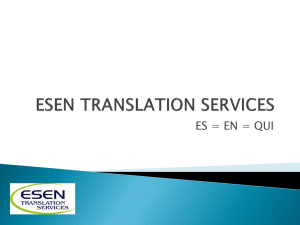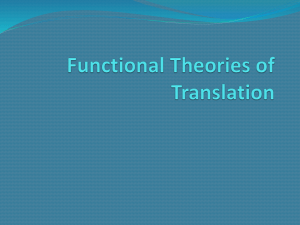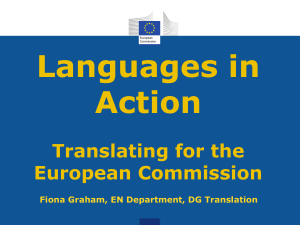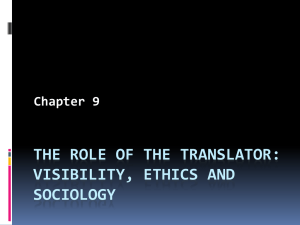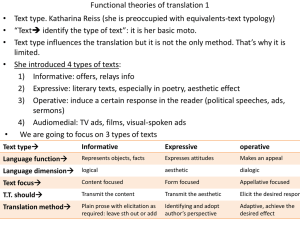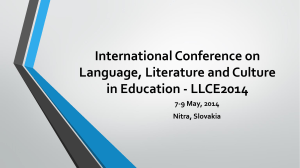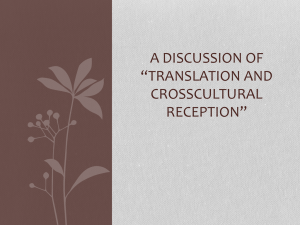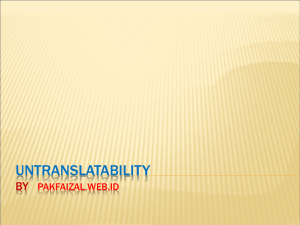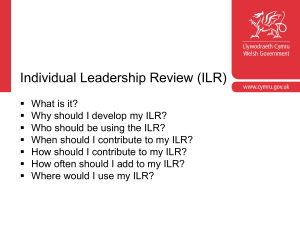Teaching Translation for ILR Level 3. Developing Students` Mindset
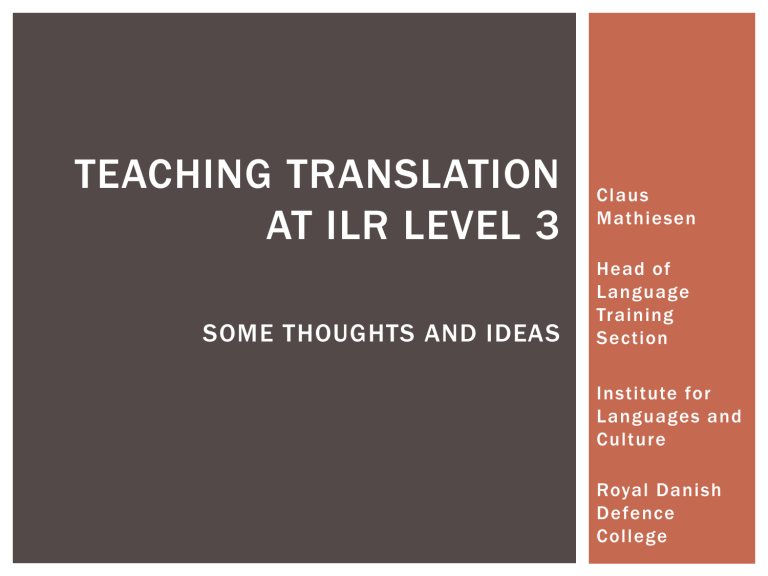
TEACHING TRANSLATION
AT ILR LEVEL 3
Claus
Mathiesen
SOME THOUGHTS AND IDEAS
Head of
Language
Training
Section
Institute for
Languages and
Culture
Royal Danish
Defence
College
THE INTUITIVE APPROACH…..
Student to me:
”Translation?
But, Claus, isn’t that just to…?”
ILR SKILL LEVEL DESCRIPTIONS FOR
TRANSLATION PERFORMANCE (PREFACE)
“A successful translation is one that conveys the explicit and implicit meaning of the source language into the target language as fully and accurately as possible .
From the standpoint of the user , the translation must also meet the prescribed specifications and deadlines.”
ILR SKILL LEVEL DESCRIPTIONS FOR
TRANSLATION PERFORMANCE (PREFACE)
“Competence in two languages is necessary but not sufficient for any translation task . Though the translator must be able to
(1) read and comprehend the source language and
(2) write comprehensibly in the target language, the translator must also be able to
(3) choose the equivalent expression in the target language that both fully conveys and best matches the meaning intended in the source language
(referred to as congruity judgment ).
ILR SKILL LEVEL DESCRIPTIONS FOR
TRANSLATION PERFORMANCE (PREFACE)
“A weakness in any of these three abilities will influence performance adversely and have a negative impact on the utility of the product. Therefore, all three abilities must be considered when assessing translation skills.”
------------------------------------------------------------------------------
(One) conclusion: When translating between two languages, you can only reach the level of your reading/writing skills in the two languages .
From a foreign language into your own: 3(?)
LEVEL 3 (PROFESSIONAL PERFORMANCE)
Can translate texts that contain not only facts but also abstract language , showing an emerging ability to capture their intended implications and many nuances .
Such texts usually contain situations and events which are subject to value judgments of a personal or institutional kind , as in some newspaper editorials, propaganda tracts, and evaluations of projects.
Linguistic knowledge of both the terminology and the means of expression specific to a subject field is strong enough to allow the translator to operate successfully within that field.
Word choice and expression generally adhere to target language norms and rarely obscure meaning.
The resulting product is a draft translation , subject to quality control.
SOME USEFUL TOOLS TO INCLUDE IN
DISCUSSIONS WITH STUDENTS
1.
MEANING
2.
INFORMATION
3.
FUNCTIONAL STYLES
-----------------------------------------
4.
TRANSLATION NORM(S)
1) SEMANTICS – MEANING - DISSECTION
Lexical
referential
pragmatic
intralinguistic
Grammatical
morphological/ grammatical categories
syntactical
Contextual
close
wider
Extralinguistic
time/place
EXTRALINGUISTIC SITUATION
(time, place, surroundings, subject matter, participants etc.)
CONTEXT – close - wider
REFERENTIAL
1) completely coinciding
2) partly coinciding
3) no coinciding
PRAGMATIC
- style (neutral, spoken, written, poetic, term)
- register (colloquial, informal, neutral, formal, ceremonial)
- emotional colouring
(negative, neutral, positive)
---------
- word order
---------
- metaphors
- connotations(?)
INTRALINGUISTIC
- rhyme, rhythmic, allitterations etc.
- word play, nicknames etc.
- such as: number, gender, case, aspects, time
- syntactical meanings (active, passive)
- OPTIONAL or
- OBLIGATORY?
2) TYPES OF INFORMATION
cognitiv
emotional-expressive
dynamic
aesthetic
COGNITIV
INFORMATION
”descriptive” compressed
AESTHETIC
INFORMATION
EMOTIONAL
INFORMATION
”subjective” metaphorical
APPELATIVE
INFORMATION
”prescriptive”
TEXT TYPES can be differentiated by the dominating type or the mix of types of information they contain
3) TYPOLOGY OF STYLES
FIVE (SIX) ”FUNCTIONAL ST YLES”
NON-FICTION
Official/business
Scientific/technical
Publicistic/newspaper
FICTION
Literary
Written
(monologic, prepared)
(conventionalized)
(”no conventions”,
”individual style”)
Colloquial
Spoken
(dialogic, unprepared)
4) TRANSLATION NORMS
equivalence – adequacy
target language correctness
style and genre
(super)pragmatics
HIERARCHY OF NORM(S)
PRAGMATICS
STYLE – and GENRE
TARGET LANGUAGE
EQUIVALENCE/ADEQUACY
GUIDELINES FOR ”DECISIONMAKING”
the dissection of meaning
the idea of the dominance of one kind of information being typical to different kinds of texts
the understanding of the hierarchy of norms in translation
provide good tools for the students, when deciding which of, normally, (too) many choices will be the best in a given situation
METHODOLOGICAL APPROACHES-1
defining the recipient(s)
picking relevant texts representing increasing complexity
providing general guidelines to the students
setting time limits/”deadlines”
DEFINING THE RECIPIENT(S)
individual/group/collective?
”persons, who are interested in the country and what is going on there, but who do not possess any specialised knowledge of the country’s background or reality”
• of utmost importance when deciding to which extent it will be necessary to make implicit meaning explicit
• ”State Duma” – ”Ptasie Mleczko”
PICKING THE RIGHT TEXTS-1
PUBLICISTIC/NEWSPAPER ST YLE
shares features with the scientific style : coherent and logical syntactical structure, careful paragraphing, expanded system of connectives
shares features with the style of belleslettres : words with emotive meaning, imagery
Publicistic vs. newspaper style
the goal of the publicistic style:
‘views’, i.e. to shape the audience, to influence public opinion, to make the audience accept the speaker’s point of view
the goal of the newspaper style:
‘news’, i.e. to inform the audience
PICKING THE RIGHT TEXTS-2
PUBLICISTIC/NEWSPAPER ST YLE
Syntactical Features
coherent and logical syntactical structure
careful paragraphing
simple rather than complex sentences
expanded system of connectives
brevity of expression
abundant use of modifiers
(adjectives, adverbs)
Lexical Features
emphasis on accessibility and easy understanding > paraphrasing rather than special terms
only established and generally understood terms (e.g. Cold
War)
evaluating adjectives (e.g. the strongest pressure, growing menace, elementary blunder)
traditional, unoriginal metaphors and similes
newspaper clichés
numerals, abbreviations, symbols
PICKING THE RIGHT TEXTS-3
PUBLICISTIC/NEWSPAPER ST YLE
short news items (preferably complete texts)
start with reports on events that could happen almost anywhere
car accidents, fires, official visits
continue with texts with a more ”local” flavour
anniversaries, social matters, etc.
move on to texts with a highly ”local” flavour including references, comments, elements of criticism, irony, humor, even poetry, etc.
15-20 texts for translation totally
STUDENT GUIDELINES-1
The purpose of reading the text before starting to translate
general idea, intention of the author, ”tone” etc.
”pre-translation analysis”
The first part of the translation is the most time -consuming
Main difficulties/challenges
Standardized expressions
situational, unseparable, clichees
Metaphors
Terminology
References to source-language reality
geography, institutions, history, culture
ethnography (dress, food, tools etc.)
intertextuality (in the broadest sense)
note: references can be ”historical” or contemporary
Poetic language
STUDENT GUIDELINES-2
What to avoid?
”argot” or ”semitranslations”
”translator’s remarks”
formulations influenced by the source language
punctuation influenced by the source language(!)
STUDENT GUIDELINES-3
on translitteration
on titles, names
on using dictionaries
on using the internet
on using web-based resources
METHODOLOGICAL APPROACHES-2
make your own ”reference translation”, before correcting the output of the students
correct the students’ translations, providing good and exact guidance
discuss (a few) general challenges in the translation with the class
develop critical/self-critical awareness in smaller groups/pairs
APPROACHES TO BE DEVELOPED IN THE
WORKING PROCESS
taking full responsibility for the translation
thoroughnes (first language competence etc.)
handling time pressure
language awareness in general
translation awareness
”the discussions during the process are more important than the result”
the possibilities of the internet have raised the bar regarding the quality of translation significantly!
if you search, you will find (almost anything)!!
”hunting instinct”
TRANSLATABILITY
Is it possible to translate everything?
Yes,
but not always without loss of meaning,
which might even be significant.
”WORD-TO-WORD” OR ”SENSE-TO-SENSE”?
( T H E O L D ES T O F AL L D I S C U S SIO NS AB O U T T R A NS L AT I O N)
as ”word-to-word” as possible (”imitating”)
as ”sense-to-sense” as necessary (”recreating”)
but first of all NATURALLY !
MISSION ACCOMPLISHED…
”Claus, now I really understand,
WHY translation is NOT just to…”
(Yeah, and you be glad, it’s only a DRAFT, too, you little i….!)
FURTHER STEPS
the described way of working with translation has proved to be a good
”stepping stone” for training:
translation to a foreign language
translation of military texts
although they mainly belong to the scientific-technical functional style
interpretation in general
